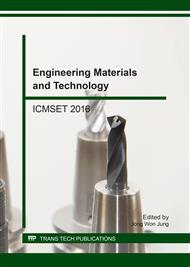[1]
A. Liaquat, M. Valenzuela, A. Ehsan, F. Díaz, N. Khattak, Characterization of Pakistani purified bentonite suitable for possible pharmaceutical application, Appl. Clay Sci. 83-84 (2013) 50-55.
DOI: 10.1016/j.clay.2013.08.007
Google Scholar
[2]
N. Amin, Use of clay as a pozzolona in high strength Portland cement and its thermal activation, Chin. J. Geochem. 29(2) (2010) 143-145.
DOI: 10.1007/s11631-010-0143-5
Google Scholar
[3]
S. Mukherjee, Uses of clays in waste managements: toxic and non-toxic, in The Science of Clays, Netherlands: Springer Netherlands, 2013, Part III, pp.309-325.
DOI: 10.1007/978-94-007-6683-9_21
Google Scholar
[4]
S. Mukherjee, Use of Clays as Drilling Fluids and Filters, in The Science of Clays, Netherlands: Springer Netherlands, 2013, Part II, pp.178-183.
DOI: 10.1007/978-94-007-6683-9_11
Google Scholar
[5]
L. Benetoli, H. Santana, C. Zaia, D. Zaia, Adsorption of nucleic acid bases on clays: an investigation using Langmuir and Freundlich isotherms and FT-IR spectroscopy, Monatsh. Chem. 139(7) (2008) 753-761.
DOI: 10.1007/s00706-008-0862-z
Google Scholar
[6]
C. Iborra, G. Cultrone, P. Cerezo, C. Aguzzi, M. Baschini, J. Vallés, A. López-Galindo, Characterisation of northern Patagonian bentonites for pharmaceutical uses, Appl. Clay Sci. 31(3-4) (2006) 272-281.
DOI: 10.1016/j.clay.2005.11.002
Google Scholar
[7]
I. Odom, Smectite clay: Mineral Properties and Uses, Phil. Trans. R. Soc. Lond. A 1984 311, 391-409.
Google Scholar
[8]
G. Kahr, F. Madsen, Determination of the cation exchange capacity and the surface area of bentonite, illite and kaolinite by methylene blue adsorption, Appl. Clay Sci. 9(5) (1995) 327-336.
DOI: 10.1016/0169-1317(94)00028-o
Google Scholar
[9]
S. Magana, P. Quintana, D. Aguilar, J. Toledo, C. Angeles-Chavez, M. Cortes, L. Leon, Y. Freile-Pelegrın, T. Lopez, R. Torres Sanchez, Antibacterial activity of montmorillonites modified with silver, J. Molecul. Catal. A: Chem. 281(1-2) (2008).
Google Scholar
[10]
E. Alvarez-Ayuso, A. Garcia-Sanchez, Removal of Heavy Metals from Waste Waters by Natural and Na-exchanged Bentonites, Clays Clay Min. 51(5) (2003) 475-480.
DOI: 10.1346/ccmn.2003.0510501
Google Scholar
[11]
A. López-Galindo, C. Viseras, P. Cerezo, Compositional, technical and safety specifications of clays to be used as pharmaceutical and cosmetic products, Appl. Clay Sci. 36(1-3) (2007) 51-63.
DOI: 10.1016/j.clay.2006.06.016
Google Scholar
[12]
R. Garrison, E. Espiritu, L. Horan, L. Mack, Petrology, Sedimentology, and Diagenesis of Hemipelagic Limestone and Tuffaceous Turbidites in the Aksitero Formation, Central Luzon, Philippines, in Geological Survey Professional Paper 1112, Washington: United States Govermenment Printing Office, (1979).
DOI: 10.3133/pp1112
Google Scholar
[13]
H. D. Chapman, 1965. Cation exchange capacity. In: Black, C.A., et al. (Ed. ), Methods of Soil Analysis. Part 2. American Society of Agronomy, Madison, pp.891-901.
DOI: 10.2134/agronmonogr9.2.c6
Google Scholar
[14]
A. D. Hitchins, T. T. Tran, J. E. McCarron, 2001. Microbiological Methods for Cosmetics, In Chapter 23, Bacteriological Analytical Manual Online, US Food and Drug Administration.
Google Scholar
[15]
A. Fisher, M. Underwood, Calibration of an X-ray Diffraction Method to Determine Relative Mineral Abundances in Bulk Powders using Matrix Singular Value Decomposition: A Test from the Barbados Accretionary Complex, Proceedings of the Ocean Drilling Program, Initial Reports, 156 (1995).
DOI: 10.2973/odp.proc.ir.156.103.1995
Google Scholar
[16]
D. Eberl, User's Guide to Rockjock - A Program for Determining Quantitative Mineralogy From Powder X-ray Diffraction Data, U.S. Geological Survey Open-File Report 03-78, (2003).
DOI: 10.3133/ofr200378
Google Scholar
[17]
S. Modabberi, A. Namayandeh, A. López-Galindo, C. Viseras, M. Setti, M. Ranjbaran, Characterization of Iranian bentonites to be used as pharmaceutical materials, Appl. Clay Sci. 116-117 (2015) 193-201.
DOI: 10.1016/j.clay.2015.03.013
Google Scholar
[18]
M. Carretero, M. Pozo, Clay and non-clay minerals in the pharmaceutical industry, Appl. Clay Sci. 46(1) (2009) 73-80.
DOI: 10.1016/j.clay.2009.07.017
Google Scholar
[19]
US Pharmacopeia <61>, Microbiological Examination of Nonsterile Products: Microbial Enumeration Tests, US Pharmacopoeial Convention, Rockville, MD, p.2503.
DOI: 10.31003/uspnf_m98800_01_01
Google Scholar


